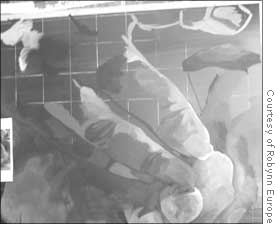
| << Front page | Arts | April 29, 2005 |
Seniors get Candid in art show
Art students tackle social issues
 |
||
| “(Nail) File Maintenance”: This painting by senior Robynn Europe is part of her senior show, Candid, in Fisher gallery. | ||
Robynn Europe and Kate Reeder’s show Candid at Fisher Hall brought in crowds of art fanatics from all over Oberlin this past Friday. Both Europe and Reeder depict the body in their pieces, but do so in strikingly different ways. Europe uses the grid system to make enlarged paintings that depict her doing things she likes to do. She plays with notions of the white male artist who paints white women in poses intended for the male gaze. Europe subverts this paradigm first by painting herself, and secondly by depicting herself in positions not intended for a Male Audience. Her four, nearly four feet tall paintings seem to take on a life of their own.
One of the first formal aspects noticeable in one painting is that it lacks a canvas. Instead, Europe uses thick sheets of wood measuring approximately four feet by four feet. This aesthetic choice can be seen as yet another rejection of the traditional canvas that white male figure painters have painted on in the past and continue to paint on in the present. As a black woman working in a medium that has been dominated by white males for centuries, Europe’s paintings are social commentaries on the art world’s whiteness.
I was put off by the fact that Europe left the remains of the grid in the background of the painting. The grid system for figure painting is a technique one usually learns in an introductory painting class as a way to create size and scale. Europe, however, presents the figure emerging out of the grid, showing the image de-contextualized from its setting and emphasizing herself, a black woman.
Using at least five layers of paint in each piece, one can tell that Europe has devoted a great amount of time and effort into her art. Her blending of colors creates a beautiful mix of skin tones that are true to life. This blending is particularly visible in “Boob Tube,” in which she depicts herself passed out in front of the TV. Her lips are shaded and blended with various pinks and reds, drawing the viewer’s attention to them apart from the other blended colors in the body. This effect only adds to the painting’s sensual feeling. One cannot help but notice the dripping paint in three out of four paintings, an aspect which detracts from these works’ aesthetic and theoretical complexity.
On the walls opposite and adjacent to Europe’s work are Kate Reeder’s photographs. Her series depicts what looks like the view from a surveillance camera in an after-party, a giant make-out festival or an orgy. The photographs are intentionally blurry in most areas, adding a sense of secrecy. The colors depicted in her work are not nearly as bright as those one would see in fashion photography even though her work is similar. Her use of texture makes these prints appealing, especially in “E. 1” in which the viewer is able to see the delicate stretch marks of an anonymous African-American person’s back. As the viewer continues down the line of photographs, she or he is assaulted by more views of this intimate festival of bodies. Black fishnet stockings, tight black leather bands, yellow shoes with black cartoon writing upon them, chains, tattoos, black bra snaps, hairy legs, black stockings and an anonymous black photo-release cord are some of the non-flesh items that abound in these photographs.
One image that stands out is a photograph that centers on a woman’s torso. This photo seems to have the same ethereal quality as Nan Goldin’s piece in which she depicts her friends. The difference between Goldin’s work and Reeder’s is that Goldin’s entire series depicts intimate relations with friends and lovers, whereas everything about Reeder’s work is secretive.
Reeder’s image of the stretched white woman’s torso is the closest that the viewer gets to genuine intimacy. In other pieces, the viewer is given only slight views of the distorted body, the body arranged in specific positions and most importantly the body that welcomes the camera in an almost pornographic way. Because the viewer is given only a peek, it feels as if she or he is a voyeur gazing through a keyhole at a cheap motel.
Reeder’s work accomplishes its interest in secrecy, but leaves the
viewer wondering. The presence of only white and then one black body raises
questions that the artist leaves unanswered. Why are the shots of the black
body more abstracted than those of the white body? Why are these people where
they are? What kinds of activities are they engaging in, and why? Are these
images violent or playful? Are the actions deviant from what society considers
“normal?” The image quality is blurry, which adds to the
voyeuristic feel. Because there are so many images and they are all so
anonymous, the viewer is not really able to come to any conclusions. It may be
that the meaning of these photographs is as secretive as the artist’s
intent.
About us
Subscriptions
Advertising